For the generation of monster kids that grew up in the early 1960s,
William Castle’s name meant just as much to audiences as the horror actors
who appeared on screen and within the pages of monster magazines. The absolute
B.T. Barnum of the world of cinema, Castle was never thought upon as a great
director, but it’s hard to think of any other like him that allowed his
audiences to have so much fun or become so interactive during a theater-going
experience. Sony salutes the king of B movie ballyhoo with this eight-feature
DVD set of Columbia Pictures releases Castle both produced and directed –
three new to the format, and the rest newly-remastered – and it's loaded
with extras, easily making it the most essential new purchase of the 2009 Halloween
viewing season.

Disc 1 commences with 13 FRIGHTENED GIRLS, Castle’s color spy
opus from 1963. The title refers to 13 teenage girls, all daughters of diplomats
from different countries, who are staying at a Swiss boarding school. An American
girl, 16-year-old Candy Hull (Kathy Dunn) is the daughter of diplomat John Hull
(Hugh Marlowe, EARTH VS. THE FLYING SAUCERS). The trouble really begins when
Candy visits the residence of her classmate Mai-Ling (Lynne Sue Moon), a sweet
little girl who happens to be from Red China and lives with her devious uncle
(Khigh Dhiegh, “Wo Fat” on “Hawaii Five-O”). While searching
for food in the kitchen, Candy discovers the body of a Russian in a freezer,
and she realizes from the letter opener thrust in his body that the murder was
meant to be pinned on the Americans. Candy immediately becomes a rather immature
and amateur secret agent, feeding information to her father’s right hand
man Wally (Murray Hamilton, JAWS), whom she has an open crush on. Known only
as “Kitty” through the information she relays, Candy is able to
keep her spy antics up while keeping her identity a secret from Wally and her
Dad, but when Wally’s assistant and love interest Soldier (Joyce Taylor,
TWICE-TOLD TALES) is kidnapped by Red China thugs, Candy has to take action
and give herself up.
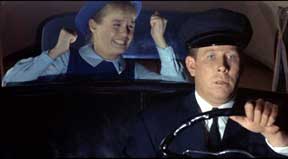 Despite
the title, this unusual mix of teens and cold war espionage is not a horror
film and was originally shot as “The Candy Web”, a more hip and
accurate title, but I suppose American audiences needed to be reminded of Castle’s
earlier hit, 13 GHOSTS. 13 FRIGHTENED GIRLS has often received pretty lousy
reviews (Leonard Maltin’s “Movie Guide” gave it a “Bomb”
rating) but it’s still something of a fan favorite, a film that takes
a while to find its stride, but when it does, becomes quite entertaining. Often
resembling a live-action 1960s Disney effort (you could almost picture Hayley
Mills in the lead), it was meant to appeal to teenage girls of the time, but
don’t let that hold you back. Despite the juvenile lure, the film still
holds up as campy fun and isn’t afraid to show fairly violent murders,
occasional displays of blood and (young) women using their sex appeal to get
what they want.
Despite
the title, this unusual mix of teens and cold war espionage is not a horror
film and was originally shot as “The Candy Web”, a more hip and
accurate title, but I suppose American audiences needed to be reminded of Castle’s
earlier hit, 13 GHOSTS. 13 FRIGHTENED GIRLS has often received pretty lousy
reviews (Leonard Maltin’s “Movie Guide” gave it a “Bomb”
rating) but it’s still something of a fan favorite, a film that takes
a while to find its stride, but when it does, becomes quite entertaining. Often
resembling a live-action 1960s Disney effort (you could almost picture Hayley
Mills in the lead), it was meant to appeal to teenage girls of the time, but
don’t let that hold you back. Despite the juvenile lure, the film still
holds up as campy fun and isn’t afraid to show fairly violent murders,
occasional displays of blood and (young) women using their sex appeal to get
what they want.
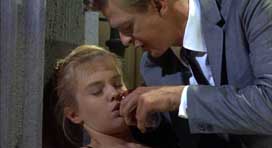
Castle’s gimmick here was mainly in the pre-publicity for the
film, before it was even shot. A campaign/contest was put together to gather
13 girls from all different countries, with the principal incentive being a
starring role in the next William Castle Hollywood production. Thirteen girls
from different countries were chosen (though several of them actually hailed
from the U.S.), and this meant the introductory scene – concerning one
of the girls doing introductory narration in their native language and driving
their classmates off in a bus – was supposedly shot 13 different times
depending on where the film was being shown (see the comments on the extras
down below), but it was likely shot less than half a dozen times. Several of
the girls went on to become familiar sex symbols in exploitation/drive-in cinema,
including British-born Alexandra Bastedo (THE BLOOD SPATTERED BRIDE, THE GHOUL)
and Judy Pace (UP IN THE CELLAR, FROGS). Look for long-time Three Stooges foil
Emil Sitka as Ludwig, the girls’ school caretaker.
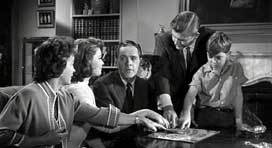 Disc
1 also features the more routine scare tactics of 13 GHOSTS (1960). Museum paleontologist
Cyrus Zorba (Donald Woods) and his family are having some problems: they’re
having trouble making their payments and most of their furniture has been taken
away. Coincidentally, the family – which includes mom Hilda (Rosemary
DeCamp), teenage daughter Medea (Jo Morrow, THE 3 WORLDS OF GULLIVER) and young
son Buck (Charles Herbert, THE FLY) – have just inherited an old house
from their estranged uncle, Dr. Zorba. Seeing the chance to move into a rent-free,
fully furnished home, the family settles in right away but are faced with the
house’s dark history. It seems that Dr. Zorba dabbled in the occult, and
with the house comes a dozen roaming spirits who haunt the place, as they’re
not at rest. These twelve ghosts can only be seen through the special goggles
created by Dr. Zorba, and it is believed that one of the inhabitants of the
house will die and will then make it 13 tormented souls frequenting the place.
Disc
1 also features the more routine scare tactics of 13 GHOSTS (1960). Museum paleontologist
Cyrus Zorba (Donald Woods) and his family are having some problems: they’re
having trouble making their payments and most of their furniture has been taken
away. Coincidentally, the family – which includes mom Hilda (Rosemary
DeCamp), teenage daughter Medea (Jo Morrow, THE 3 WORLDS OF GULLIVER) and young
son Buck (Charles Herbert, THE FLY) – have just inherited an old house
from their estranged uncle, Dr. Zorba. Seeing the chance to move into a rent-free,
fully furnished home, the family settles in right away but are faced with the
house’s dark history. It seems that Dr. Zorba dabbled in the occult, and
with the house comes a dozen roaming spirits who haunt the place, as they’re
not at rest. These twelve ghosts can only be seen through the special goggles
created by Dr. Zorba, and it is believed that one of the inhabitants of the
house will die and will then make it 13 tormented souls frequenting the place.
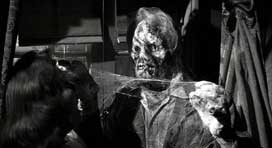
Though 13 GHOSTS doesn’t have as many cheap thrills as Castle’s
earlier THE HOUSE ON HAUNTED HILL or even THE TINGLER, it still works as a family-friendly
update of the “Old Dark House” chestnut. The very likable Zorba
family is right out of a 1950s television sitcom, and Charles Herbert is especially
a joy as the tyke who’s fascinated with all things supernatural, initiating
a Ouija Board session on the family’s coffee table and later making a
startling discovery hidden in the house. Margaret Hamilton (as the Zorba family
housekeeper, Elaine Zacharides) looks every bit the witch (something young Buck
asks her if she really is) as she somberly sends up her famous WIZARD OF OZ
persona, not having to do anything significant to imply this except raise her
eyebrow to the audience and walk off with a broom in her final shot. Martin
Milner (who was on the hit series “Route 66” when this was released)
is really good as the clean-cut attorney whose character is not all what he
seems.
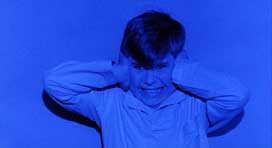 The
central gimmick when the film was originally screened is “Illusion-O.”
In a nutshell, theater patrons were given a cardboard visor (titles on the screen
tell you when to use it) with separate red and blue tinted square cellophane
options. The black & white film had its ghost scenes tinted blue, with the
superimposed apparitions appearing in a rent tint. Look through the “ghost
viewer” square (red) to see the ghosts, while the “ghost remover”
square (blue) removed them. Not much of a gimmick when you think about it (who
wouldn’t want to see the ghosts?) but a memorable one nonetheless. The
ghosts on display include a flaming skeleton, a lion and its headless tamer,
an irate chef along with hid cheating wife and her lover, and the horrible-looking
Dr. Zorba himself. Castle appears on screen, explaning the Illusion-O process
to the audience, and he does the outro as well.
The
central gimmick when the film was originally screened is “Illusion-O.”
In a nutshell, theater patrons were given a cardboard visor (titles on the screen
tell you when to use it) with separate red and blue tinted square cellophane
options. The black & white film had its ghost scenes tinted blue, with the
superimposed apparitions appearing in a rent tint. Look through the “ghost
viewer” square (red) to see the ghosts, while the “ghost remover”
square (blue) removed them. Not much of a gimmick when you think about it (who
wouldn’t want to see the ghosts?) but a memorable one nonetheless. The
ghosts on display include a flaming skeleton, a lion and its headless tamer,
an irate chef along with hid cheating wife and her lover, and the horrible-looking
Dr. Zorba himself. Castle appears on screen, explaning the Illusion-O process
to the audience, and he does the outro as well.
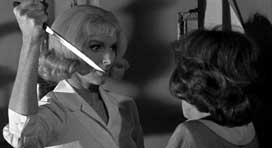
HOMICIDAL is William Castle's homage to Hitchcock's PSYCHO, and it's
one of the director's sleaziest efforts and probably wasn't meant as Saturday
afternoon kiddy fare like most of his previous efforts. Wanting not to cast
a familiar face in the lead, Castle hired pretty actress Joan Marshall and changed
her name to a more ambiguous Jean Arliss for the film’s credits. After
a brief and rather straight-laced introduction by old Bill, we then see a flashback
of a weird-looking boy nabbing a baby doll from his sobbing sister. Some 13
years later, a 20-year-old woman named Emily (Arliss) checks into a hotel and
asks a bellboy to come up to her room. Flaunting a wad of cash, Emily offers
to pay the bellboy to marry her on a specific date, making it known that the
marriage will be annulled immediately. The guy is confused, but accepts the
offer.
 That
night, Emily and the bellboy go to a justice of the peace to be wed. After he
marries them, she viciously stabs the justice in the stomach in a scene that
was pretty damn gory for 1961. She then goes into hiding as the nurse of a mute,
wheelchair-bound old lady (Eugenie Leontovitch). Emily's behavior arouses the
suspicion of Miriam (Patricia Breslin), the old woman's niece who runs a flower
shop nearby. Later, the police show up to the shop and alert Miriam to the fact
that a homicidal murderess checked into a hotel using her name, so now she's
convinced of Emily's shiftiness. Back in town is Miriam's brother
Warren, and he was the one that is thought to have hired Emily to take care
of the old lady while in Denmark(?).
That
night, Emily and the bellboy go to a justice of the peace to be wed. After he
marries them, she viciously stabs the justice in the stomach in a scene that
was pretty damn gory for 1961. She then goes into hiding as the nurse of a mute,
wheelchair-bound old lady (Eugenie Leontovitch). Emily's behavior arouses the
suspicion of Miriam (Patricia Breslin), the old woman's niece who runs a flower
shop nearby. Later, the police show up to the shop and alert Miriam to the fact
that a homicidal murderess checked into a hotel using her name, so now she's
convinced of Emily's shiftiness. Back in town is Miriam's brother
Warren, and he was the one that is thought to have hired Emily to take care
of the old lady while in Denmark(?).
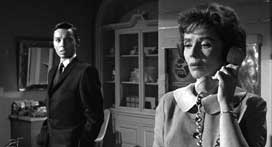
Now, I don't want to spoil it for those who haven't seen the film,
but years of cinematic conditioning will lead anyone today to realize that Emily
and Warren are one in the same and played by the same actress. As a man, Arliss
has her hair shortened, darkened and matted, and she also sports some large
false teeth and other face make-up. The actress is dubbed by a less than masculine
man's voice! This makes for some pretty creeping viewing – and Arliss
is actually convincing as a male, in bizarre kind of way. She's
quite chilling and disturbing in the role (the other performances are not too
memorable) and a murder on a staircase is still pretty scary when viewed today.
Robb White's screenplay is somewhat confusing (incorporating an inheritance
as a murder motive), and unlike in PSYCHO, Simon "Vincenzo" Oakland
is not on hand to explain what a transvestite is. During the final few minutes,
there's the gimmick of the "Fright Break," a 45-second countdown clock
that warns you before the camera enters a closed door, soon to unveil horrific
events.
 The
second feature on Disc 2 is STRAIT JACKET (1964). After years of excessive promotional
gimmicks, William Castle decided to lessen the ballyhoo and create a vehicle
for a true Hollywood star. After studying the box office receipts of WHATEVER
HAPPENED TO BABY JANE, Castle offered Robert Bloch's screenplay to the legendary
Joan Crawford. Crawford accepted, but in typical Joan fashion, she had the story
re-written to pacify her ego and the on-the-set demands quickly piled up. According
to Castle, Crawford was "demanding" but she was not "difficult."
The
second feature on Disc 2 is STRAIT JACKET (1964). After years of excessive promotional
gimmicks, William Castle decided to lessen the ballyhoo and create a vehicle
for a true Hollywood star. After studying the box office receipts of WHATEVER
HAPPENED TO BABY JANE, Castle offered Robert Bloch's screenplay to the legendary
Joan Crawford. Crawford accepted, but in typical Joan fashion, she had the story
re-written to pacify her ego and the on-the-set demands quickly piled up. According
to Castle, Crawford was "demanding" but she was not "difficult."

The film opens with a steamy Tennessee Williams-esqe flashback of Lucy
Harper (Crawford, who was pushing 60 at the time) coming home to find her much
younger husband (an early role by Lee Majors) in the sack with the local hussy.
Lucy grabs an axe from outside and viciously does them both in –
all while her young daughter looks on in total shock. Twenty years later,
Lucy is released from an asylum and comes to stay with her now adult daughter
Carol (Diane Baker), her brother (Leif Erickson) and her sister-in-law (Rochelle
Hudson, GALLERY OF HORRORS) at their peaceful farm. Carol wants to help her
nervous mother to be happy, so she buys her a black wig and a fancy floral dress
and Lucy looks like a new woman. Soon, poor Lucy starts hearing "Lizzie
Borden" nursery rhymes and seeing decapitated heads on her pillow. A number
of murders follow, and Lucy may or may not be responsible...
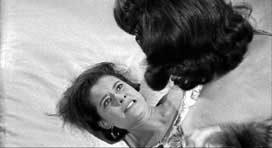 STRAIT
JACKET is not the best William Castle film and can be a bit slow at times, but
it's still got some nice shocks, a killer ending, and some really strong performances
– especially from its star. Crawford eats up the scenery and steals nearly
every scene she's in, only entering camp territory on several occasions –
especially when she gets drunk and tries to seduce her daughter's boyfriend
or when she spontaneously lights a match on a spinning jazz record! Also in
the cast is a pre-Oscar, dark-haired George Kennedy who is almost unrecognizable
as a shabby farmhand. And pay close attention to the Columbia statue at the
very end!
STRAIT
JACKET is not the best William Castle film and can be a bit slow at times, but
it's still got some nice shocks, a killer ending, and some really strong performances
– especially from its star. Crawford eats up the scenery and steals nearly
every scene she's in, only entering camp territory on several occasions –
especially when she gets drunk and tries to seduce her daughter's boyfriend
or when she spontaneously lights a match on a spinning jazz record! Also in
the cast is a pre-Oscar, dark-haired George Kennedy who is almost unrecognizable
as a shabby farmhand. And pay close attention to the Columbia statue at the
very end!

Disc 3 begins with THE OLD DARK HOUSE (1963), a film which boasts title
background art by Charles Addams himself. American car salesman Tom Penderel
(Tom Poston) is living in London with a strange flat-mate named Casper Femm
(Peter Bull). Casper requests that Tom deliver the new car he sold him to the
Femm family house. Tom screws up that assignment by causing a gargoyle statue
to plunge on the car’s engine, but when he gets inside the Femm house,
he’s in for all sorts of macabre encounters. All the eccentric family
members are attached to the crumbling, ceiling-cracked abode to secure their
share of an inheritance, and naturally, this greed leads to murder. When the
friendly and unsuspecting Tom enters the house, he is greeted by the news that
his old friend Casper has died by falling down the stairs (though certain family
members believe otherwise as to the cause of his death) and that he has a twin
brother (Bull again) whose own life is one of a handful who is in danger.
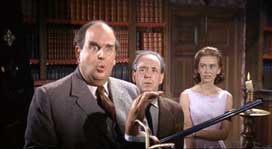 Although
based on the J.B. Priestley’s novel, THE OLD DARK HOUSE has very little
to do with the 1932 Universal film. For this, Castle went to England to make
the film with Hammer Films (so folks, thanks to the kind people at Sony, you
now have another Hammer DVD to add to your collection) while they were still
based at Bray Studios. Even though this is not considered one of Hammer’s
better achievements (nor Castle’s), it’s got most of the recognizable
Hammer qualities in cinematography and set design, and a lot of the familiar
Hammer personnel were on the production (production designer Bernard Robinson,
cinematographer Arthur Grant, make-up artist Roy Ashton, special effects artist
Les Bowie, etc.). If you recognize the front of “the old dark house”,
that’s because it’s Oakley Court, a site used in a handful of early
Hammer films, as well as later British horror films like AND NOW THE SCREAMING
STARTS and VAMPYRES. It’s probably best known today as the home of Frank-N-Furter
in THE ROCKY HORROR PICTURE SHOW (1975). It’s now a prestigious country
house hotel.
Although
based on the J.B. Priestley’s novel, THE OLD DARK HOUSE has very little
to do with the 1932 Universal film. For this, Castle went to England to make
the film with Hammer Films (so folks, thanks to the kind people at Sony, you
now have another Hammer DVD to add to your collection) while they were still
based at Bray Studios. Even though this is not considered one of Hammer’s
better achievements (nor Castle’s), it’s got most of the recognizable
Hammer qualities in cinematography and set design, and a lot of the familiar
Hammer personnel were on the production (production designer Bernard Robinson,
cinematographer Arthur Grant, make-up artist Roy Ashton, special effects artist
Les Bowie, etc.). If you recognize the front of “the old dark house”,
that’s because it’s Oakley Court, a site used in a handful of early
Hammer films, as well as later British horror films like AND NOW THE SCREAMING
STARTS and VAMPYRES. It’s probably best known today as the home of Frank-N-Furter
in THE ROCKY HORROR PICTURE SHOW (1975). It’s now a prestigious country
house hotel.
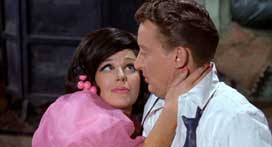
Though the British were never known for their horror send-ups (WHAT
A CARVE UP, THE HORROR OF IT ALL), THE OLD DARK HOUSE can still be enjoyable
due to good production values and a fine cast pitted against a bewildered Tom
Poston, even though most of the jokes go nowhere (though some of the sight gags
succeed). Screen legend Robert Morley plays a rotund uncle obsessed with his
rifle collection, while Joyce Grenfell is the aunt obsessed with knitting miles
of fabric her with her elongated needles. Mervyn Johns (Bob Cratchit in the
timeless 1951 version of A CHRISTMAS CAROL) is another uncle who believes the
world is coming to an end, so he build’s an ark complete with a variety
of animals to go inside. Beautiful Janette Scott (DAY OF THE TRIFFIDS) is the
seemingly sweet cousin, while Danny Green (who sort of resembles Popeye’s
animated nemesis Bluto) is a silent brute constantly chasing poor Tom in and
around the house. Most memorable is Fenella Fielding (CARRY ON SCREAMING, probably
the best of the British horror spoofs) as the vampish Morgana, always on the
seductive make for timid Tom. Incidentally, THE OLD DARK HOUSE was shown in
theaters in black & white (on a double bill with Hammer’s psychological
thriller MANIAC, which will probably be out on DVD in 2010), but shown on TV
in color. Fortunately for us, Sony has opted to include the definitive color
version for this set.
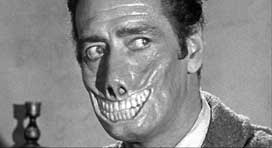 The
second film on Disc 3 is MR. SARDONICUS (1961). The idea for this one came about
when Castle was browsing through Playboy magazine one day and what
caught his eyes (of all things) was a novella titled "Sardonicus"
by Ray Russell. Castle purchased the rights to the story and gave us one of
his most memorable efforts. Transforming Columbia's soundstage to resemble period
Europe, the film delivers a satisfying gothic mix of psychological horror and
cheap thrills.
The
second film on Disc 3 is MR. SARDONICUS (1961). The idea for this one came about
when Castle was browsing through Playboy magazine one day and what
caught his eyes (of all things) was a novella titled "Sardonicus"
by Ray Russell. Castle purchased the rights to the story and gave us one of
his most memorable efforts. Transforming Columbia's soundstage to resemble period
Europe, the film delivers a satisfying gothic mix of psychological horror and
cheap thrills.

In a role that would have been perfect for Vincent Price (he was steadily
working with AIP at the time), lanky Guy Rolfe (THE STRANGLERS OF BOMBAY) deliciously
plays the title character. Initially, he was a pauper who discovers that his
late father was buried with a winning lottery ticket. When uncovering the coffin
lid, the shock of seeing the father's decaying skull causes his face to freeze
in a ghoulish grimace. Now changing his name to Sardonicus, his wealth allows
him to become a baron, and he now resides in a castle with his second wife,
Maude (Audrey Dalton).
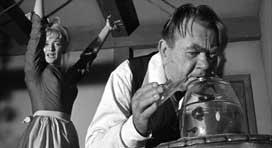 Sardonicus
calls upon a well-known London neurosurgeon Sir Robert (SCREAM/TASTE OF FEAR's
Ronald Lewis) – his wife's former lover –
to travel to his castle and attempt to cure him. When Sir Robert arrives,
he's shocked to discover experimental leech applications to the maid, administered
by Krull (Oskar Homolka), Sardonicus' vile assistant. Top-billed Homolka plays
it properly creepy, possessing only one eye after his master plucked the other
one out. Finding Sardonicus to be cold-hearted and ruthless, Sir Robert is blackmailed
into helping the smiling Baron (who wears an expressionless mask to conceal
his deformity), but it's he who gets the last laugh in the end.
Sardonicus
calls upon a well-known London neurosurgeon Sir Robert (SCREAM/TASTE OF FEAR's
Ronald Lewis) – his wife's former lover –
to travel to his castle and attempt to cure him. When Sir Robert arrives,
he's shocked to discover experimental leech applications to the maid, administered
by Krull (Oskar Homolka), Sardonicus' vile assistant. Top-billed Homolka plays
it properly creepy, possessing only one eye after his master plucked the other
one out. Finding Sardonicus to be cold-hearted and ruthless, Sir Robert is blackmailed
into helping the smiling Baron (who wears an expressionless mask to conceal
his deformity), but it's he who gets the last laugh in the end.

Castle is on hand to introduce the film, hamming it up from what is
supposed to be the foggy streets of London. Towards the end, he appears again
to carry out the "Punishment Poll," inviting the audience to vote
on whether Sardonicus should be shown mercy or not. Theater patrons were asked
to hold up a card (thumbs up or thumbs down) to vote for his fate while Castle
pretends to tally up the votes. Of course, there's only one ending and fate
for Sardonicus, but Castle later claimed that he actually filmed a different
one just in case (as if the usher was going to count votes and tell the projectionist
to stop everything!). But then again, knowing the showman that Castle was, he'd
want fans to believe that.
 Disc
4 begins with THE TINGLER (1959), which also happens to be the oldest film in
this collection. Vincent Price plays Dr. Warren Chapin, a busy pathologist experimenting
on the effects of fear with his young assistant (Darryl Hickman). Warren decides
to use his floozy, adulteress wife (Patricia Cutts) in his experiments, causing
her to faint and taking an x-ray of her back. What is discovered is something
he deems “the tingler,” a lobster-tail like parasite which manifests
itself on the spinal cords of terrified people. The only way to stop the tingler
is to scream, and theoretically, in its spinal habitat, it should return to
miniscule size. An ideal opportunity to remove a living, full grown tingler
arrives when new friend Ollie (Philip Coolidge) brings his ailing wife Martha
(Judith Evelyn, REAR WINDOW) to Warren’s home. Too late for her life to
be saved, Martha – a deaf mute – apparently died of fear without
the ability to scream, thus her tingler is removed, hence opening up a Pandora’s
Box of horrors when it’s let loose in a movie theater.
Disc
4 begins with THE TINGLER (1959), which also happens to be the oldest film in
this collection. Vincent Price plays Dr. Warren Chapin, a busy pathologist experimenting
on the effects of fear with his young assistant (Darryl Hickman). Warren decides
to use his floozy, adulteress wife (Patricia Cutts) in his experiments, causing
her to faint and taking an x-ray of her back. What is discovered is something
he deems “the tingler,” a lobster-tail like parasite which manifests
itself on the spinal cords of terrified people. The only way to stop the tingler
is to scream, and theoretically, in its spinal habitat, it should return to
miniscule size. An ideal opportunity to remove a living, full grown tingler
arrives when new friend Ollie (Philip Coolidge) brings his ailing wife Martha
(Judith Evelyn, REAR WINDOW) to Warren’s home. Too late for her life to
be saved, Martha – a deaf mute – apparently died of fear without
the ability to scream, thus her tingler is removed, hence opening up a Pandora’s
Box of horrors when it’s let loose in a movie theater.
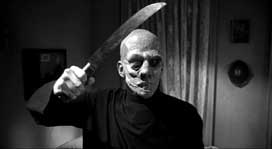
Vincent Price (still a few years before becoming a horror movie icon)
had just starred in Castle’s hit THE HOUSE ON HAUNTED HILL, so bringing
him back for THE TINGLER was a natural, giving us one of the most unforgettable
(if very campy) monster movie of the 1950s. Screenwriter Robb White (who scripted
a number of Castle horror films, including MACABRE and 13 GHOSTS) came up with
a very original idea, incorporating a small and simple but unsettling creature,
and the film also features a number of attention-grabbing gimmicks within. Price
holds the film together well (though it’s full of fine supporting players)
mixing his usual appealing professionalism with his more hammy acting facets.
This is fully on display when his character has to inject himself with hallucinatory
drugs to induce fear , so seeing Price pretending to take acid is, well, a real
trip. This is believed to be the first time anyone was ever seen using LSD in
a movie.
 Probably
Castle’s most famous production in terms of ballyhoo, THE TINGLER’s
central gimmick is “Percepto” which included the wiring of select
theater seats to give patrons a slight buzz during the scene when the tingler
is set loose in a silent movie house (at this point, the screen goes black for
a second time, and Price announces that the audience must scream if they don’t
want to die). Along with Castle’s on-screen introduction and some initial,
irritating shots of some very loud screaming, floating heads, the film’s
other unforgettable sequence of sheer exploitation is when Martha is scared
to death in her own home, with such imagery as a knife-wielding ghoul rising
from a bed and a hairy, animal-like arm swinging a hatchet. The black and white
film then reveals vibrant red blood pouring from the faucet, as well as a bath
drawn of blood, with an arm reaching out from the mucky crimson stuff.
Probably
Castle’s most famous production in terms of ballyhoo, THE TINGLER’s
central gimmick is “Percepto” which included the wiring of select
theater seats to give patrons a slight buzz during the scene when the tingler
is set loose in a silent movie house (at this point, the screen goes black for
a second time, and Price announces that the audience must scream if they don’t
want to die). Along with Castle’s on-screen introduction and some initial,
irritating shots of some very loud screaming, floating heads, the film’s
other unforgettable sequence of sheer exploitation is when Martha is scared
to death in her own home, with such imagery as a knife-wielding ghoul rising
from a bed and a hairy, animal-like arm swinging a hatchet. The black and white
film then reveals vibrant red blood pouring from the faucet, as well as a bath
drawn of blood, with an arm reaching out from the mucky crimson stuff.

Disc 4’s second feature is ZOTZ! (1962). Health conscious and
environmentally aware university professor Jonathan Jones (Tom Poston) gets
a hold of an ancient coin that belongs to his live-in niece (Zeme North). When
in possession of this coin, Jones is given special powers, enabling him to cause
pain to any living thing he points to, or decelerate anyone by saying “zots!”
out loud. The combination of doing both at the same time proves deadly as done
to a moth and then a small lizard. Being intelligent but a bit of a social buffoon,
Jones first tries showing off the coin and its power to his boss, Dean Updike
(Cecil Kellaway, THE MUMMY’S HAND) and then to military hotshot General
Bullivar (Fred Clark), but both demonstrations fail miserably. Spies from communist
Russia become aware that Jones has some sort of deadly weapon, tricking him
into taking a plane ride and taking him hostage, as well as kidnapping his niece
and his new lover interest (Julia Meade). Jones has to think fast to use the
power of the coin wisely to outwit the commies and save the two women that mean
the most in his life.
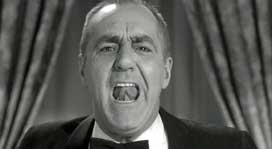 A
strange fantasy/comedy in the tradition of the live action Disney films of the
period (Disney optioned to buy the property from Castle before shooting, but
he turned them down), ZOTZ! is mildly amusing, but fails in comparison to classics
such as THE ABSENT MINDED PROFESSOR. The comedy and the special effects are
spotty at best, and the whole idea of the coin and its erratic abilities seems
half-baked, at least when brought to the screen on a low budget Castle production.
Some of the funnier bits are when Jones is riding his bicycle to work, reading
a book on his handlebars and nearly causing a dozen accidents; when Jones lets
a cage full of white mice loose at a cocktail party (which includes attendee
Margaret Dumont, the frequent co-star of the Marx Brothers in one of her final
films); and the utilizing of the zotz power to slow up a maudlin dinner speech
(given by the great Jim Backus) to the point where his words are garbled nonsense.
Mike Mazurki can be seen as a commie thug named Igor, Louis Nye has an unbilled
in-joke cameo, and there’s a nostalgic scene where a young couple goes
to see HOMICIAL at a California drive-in theater.
A
strange fantasy/comedy in the tradition of the live action Disney films of the
period (Disney optioned to buy the property from Castle before shooting, but
he turned them down), ZOTZ! is mildly amusing, but fails in comparison to classics
such as THE ABSENT MINDED PROFESSOR. The comedy and the special effects are
spotty at best, and the whole idea of the coin and its erratic abilities seems
half-baked, at least when brought to the screen on a low budget Castle production.
Some of the funnier bits are when Jones is riding his bicycle to work, reading
a book on his handlebars and nearly causing a dozen accidents; when Jones lets
a cage full of white mice loose at a cocktail party (which includes attendee
Margaret Dumont, the frequent co-star of the Marx Brothers in one of her final
films); and the utilizing of the zotz power to slow up a maudlin dinner speech
(given by the great Jim Backus) to the point where his words are garbled nonsense.
Mike Mazurki can be seen as a commie thug named Igor, Louis Nye has an unbilled
in-joke cameo, and there’s a nostalgic scene where a young couple goes
to see HOMICIAL at a California drive-in theater.
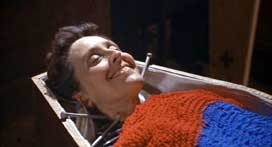
As you can expect from Sony, the transfers here only bring one word
to mind: perfection. THE TINGLER, HOMICIDAL, 13 GHOSTS, MR. SARDONICUS and STRAIT-JACKET
had all been previously released as single DVDs before, but here they are all
presented in newly-remastered transfers, all cleaned up and noticeably improved.
This is especially the case with HOMICIDAL (previously only available full frame)
which is now presented in its proper 1.85:1 aspect ratio with anamorphic enhancement
(like all the other titles on this set). The blue and red tinted sequences on
13 GHOSTS are now more vivid, so the appearance of the spooks also stand out
better than ever (the “ghost viewer”, which works when watching
this new transfer, is not included here, nor is the shorter, gimmick-free black
and white version found on the flip side of the 2001 single disc). The two color
films, 13 FRIGHTENED GIRLS and THE OLD DARK HOUSE, look quite stunning, comparable
to the excellent color transfers found on Sony’s first two DVD sets devoted
to 1960s era Hammer films. ZOTZ!, like the other newly-remastered black and
white films here, also looks great, and there’s hardly a blemish to be
found on any of the transfers. All eight films contain solid English mono audio
tracks, with no subtitle or other language options included.
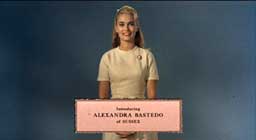 Disc
1’s 13 FRIGHTENED GIRLS extras include the original British trailer introduction
(featuring beautiful Alexandra Bastedo) the original trailer under the “Candy
Web” title and the original “Candy Web” theatrical opening
and closing messages from William Castle. There are also four different alternative
opening scenes, all shot with different actresses doing narration (in their
respective languages: British, Swedish, French and German)
and getting to drive their classmates off in a school bus. Lastly for 13 FRIGHTENED
GIRLS is the original trailer under that title. For 13 GHOSTS, there’s
the short and sweet 2001 featurette, “The Magic of Illusion-O”,
which includes interviews with film historians/filmmakers/fans such as Donald
F. Glut, Fred Olen Ray, Michael Schlesinger and Bob Burns. The original trailer
is also on hand, which includes onscreen host Castle asking his audience, “Do
you believe in ghosts?” as well as some creepy narration by Paul Frees.
Disc
1’s 13 FRIGHTENED GIRLS extras include the original British trailer introduction
(featuring beautiful Alexandra Bastedo) the original trailer under the “Candy
Web” title and the original “Candy Web” theatrical opening
and closing messages from William Castle. There are also four different alternative
opening scenes, all shot with different actresses doing narration (in their
respective languages: British, Swedish, French and German)
and getting to drive their classmates off in a school bus. Lastly for 13 FRIGHTENED
GIRLS is the original trailer under that title. For 13 GHOSTS, there’s
the short and sweet 2001 featurette, “The Magic of Illusion-O”,
which includes interviews with film historians/filmmakers/fans such as Donald
F. Glut, Fred Olen Ray, Michael Schlesinger and Bob Burns. The original trailer
is also on hand, which includes onscreen host Castle asking his audience, “Do
you believe in ghosts?” as well as some creepy narration by Paul Frees.
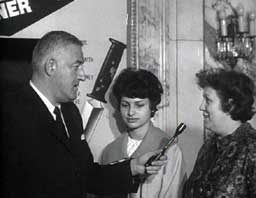
Disc 2’s extras include a 2002 featurette called, "Psychette:
William Castle and Homicidal," that contains interviews with film historians/fans
such as David Del Valle, Donald F. Glut, Fred Olen Ray, Michael Schlesinger
and Bob Burns. New to this DVD set is “Homicidal Youngstown, Ohio Premiere”,
a vintage featurette which contains footage of Castle gleefully interviewing
satisfied theater patrons in front of the "Coward's Corner" (a booth
for "scared" HOMICIDAL viewers). A HOMICIDAL trailer is also included,
but it’s actually a 20-second TV spot narrated by Paul Frees (doing what
appears to be a Boris Karloff impersonation). Extras for STRAIT JACKET include
an excellent 2002 featurette entitled, "Battle-Axe: The Making of Strait-Jacket."
This is mainly made up of some interesting interviews with film historian David
Del Valle and STRAIT JACKET star Diane Baker (actually, Baker was a replacement
when Joan had the original actress playing her daughter fired!). Baker reflects
on performing with the stubborn legend, and Del Valle discloses some fascinating
production facts (Joan's allegiance to her husband's Pepsi corporation made
them cast a non-acting company bigwig as her doctor in the film!). And from
the Columbia vaults comes some more welcomed extras. There are a few minutes
of Crawford's wardrobe and make-up tests for the film. Here, Joan models the
various outfits she wears in STRAIT JACKET while making some very confident
faces and posing like the bona fide star that she was. Also included is "The
Ax-Swinging Screen Test," which is brief footage of Joan chopping off a
phony head with blood generously flowing (nothing this graphic is actually shown
in the film, as the sequence was darkened up in the final product). The vintage
featurette, “How to Plan a Movie Murder”, is presented on DVD for
the first time here. It’s amusing little piece; a fully scripted session
with Crawford, Castle and Bloch in a staged living room meeting where they pre-discuss
the murders for the film and conclude by marching off with axes in hand. Lastly,
there a STRAIT JACKET TV spot narrated by Joan, and the original trailer.
 Disc
3’s extras include the original trailer for THE OLD DARK HOUSE, and it
appears to be the British one, which is a good thing. There's a fun 2001 behind-the-scenes
MR. SARDONICUS featurette called "Taking The Punishment Poll" which
contains interviews with David Del Valle, Don Glut, Michael Schlesinger, Fred
Olen Ray and Bob Burns, who proudly shows off his original "Punishment
Poll" card. A surprise extra on this set is the 1972 pilot episode of the
Castle executive-produced series, "Ghost Story". The episode, entitled
“The New House” was written by Richard Matheson and directed by
John Llewellyn Moxey (THE NIGHT STALKER). It concerns a young couple (David
Birney and Barbara Parkins) buying a new house which was built over the grounds
where a young woman was innocently hanged centuries ago. Sam Jaffe also stars
as a retired librarian, and Sebastian Cabot of course is the on-screen host.
If the excellent quality here is any indication of how the entire GHOST STORY
series might look on DVD, then we’re in for something special when that
time comes. The last extra on the disc is MR. SARDNONICUS’ original theatrical
trailer.
Disc
3’s extras include the original trailer for THE OLD DARK HOUSE, and it
appears to be the British one, which is a good thing. There's a fun 2001 behind-the-scenes
MR. SARDONICUS featurette called "Taking The Punishment Poll" which
contains interviews with David Del Valle, Don Glut, Michael Schlesinger, Fred
Olen Ray and Bob Burns, who proudly shows off his original "Punishment
Poll" card. A surprise extra on this set is the 1972 pilot episode of the
Castle executive-produced series, "Ghost Story". The episode, entitled
“The New House” was written by Richard Matheson and directed by
John Llewellyn Moxey (THE NIGHT STALKER). It concerns a young couple (David
Birney and Barbara Parkins) buying a new house which was built over the grounds
where a young woman was innocently hanged centuries ago. Sam Jaffe also stars
as a retired librarian, and Sebastian Cabot of course is the on-screen host.
If the excellent quality here is any indication of how the entire GHOST STORY
series might look on DVD, then we’re in for something special when that
time comes. The last extra on the disc is MR. SARDNONICUS’ original theatrical
trailer.
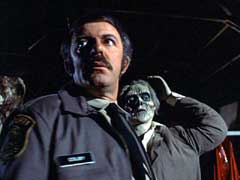
Disc 4’s extras include the 15-minute featurette “Scream
For Your Lives: William Castle and The Tingler.” This piece dates back
to the original 1999 TINGLER DVD release, but still holds up just as well a
decade later. This includes interviews with star Darryl Hickman (who shares
some truly funny anecdotes about Castle, and incidentally came on the film to
work alongside his then-fiancée Pamela Lincoln), film historian David
J. Skal, Vincent Price biographer Lucy Chase Williams and Bob Burns, who helped
with the film’s promotional campaign, for which we are treated to some
great archive footage and rare stills. The “Alternate Drive-In Sequence”
is a different version of the on-screen warning about the tingler, telling patrons
to flash their headlights to scare it away. The narration is by Castle rather
than Price. The “Original Scream Sequence” is a livelier version
of break when Price asks the audience to scream for their lives, with much louder
audience responses and more panicky banter. This disc also includes an episode
of the Castle executive-produced "Ghost Story", but by this time the
program was known as "Circle of Fear". The 1973 episode, entitled
“Graveyard Shift,” stars John Astin as a former horror movie actor,
now working as an overnight security guard at the studio he used to act for,
with his past coming back to haunt him. Then-spouse Patty Duke plays his pregnant
wife, and Castle himself plays the elder studio head, giving a speech much akin
to his own career.
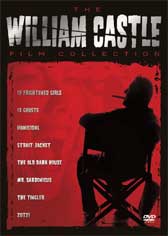 THE
WILLIAM CASTLE FILM COLLECTION
THE
WILLIAM CASTLE FILM COLLECTION
 Despite
the title, this unusual mix of teens and cold war espionage is not a horror
film and was originally shot as “The Candy Web”, a more hip and
accurate title, but I suppose American audiences needed to be reminded of Castle’s
earlier hit, 13 GHOSTS. 13 FRIGHTENED GIRLS has often received pretty lousy
reviews (Leonard Maltin’s “Movie Guide” gave it a “Bomb”
rating) but it’s still something of a fan favorite, a film that takes
a while to find its stride, but when it does, becomes quite entertaining. Often
resembling a live-action 1960s Disney effort (you could almost picture Hayley
Mills in the lead), it was meant to appeal to teenage girls of the time, but
don’t let that hold you back. Despite the juvenile lure, the film still
holds up as campy fun and isn’t afraid to show fairly violent murders,
occasional displays of blood and (young) women using their sex appeal to get
what they want.
Despite
the title, this unusual mix of teens and cold war espionage is not a horror
film and was originally shot as “The Candy Web”, a more hip and
accurate title, but I suppose American audiences needed to be reminded of Castle’s
earlier hit, 13 GHOSTS. 13 FRIGHTENED GIRLS has often received pretty lousy
reviews (Leonard Maltin’s “Movie Guide” gave it a “Bomb”
rating) but it’s still something of a fan favorite, a film that takes
a while to find its stride, but when it does, becomes quite entertaining. Often
resembling a live-action 1960s Disney effort (you could almost picture Hayley
Mills in the lead), it was meant to appeal to teenage girls of the time, but
don’t let that hold you back. Despite the juvenile lure, the film still
holds up as campy fun and isn’t afraid to show fairly violent murders,
occasional displays of blood and (young) women using their sex appeal to get
what they want. 
 Disc
1 also features the more routine scare tactics of 13 GHOSTS (1960). Museum paleontologist
Cyrus Zorba (Donald Woods) and his family are having some problems: they’re
having trouble making their payments and most of their furniture has been taken
away. Coincidentally, the family – which includes mom Hilda (Rosemary
DeCamp), teenage daughter Medea (Jo Morrow, THE 3 WORLDS OF GULLIVER) and young
son Buck (Charles Herbert, THE FLY) – have just inherited an old house
from their estranged uncle, Dr. Zorba. Seeing the chance to move into a rent-free,
fully furnished home, the family settles in right away but are faced with the
house’s dark history. It seems that Dr. Zorba dabbled in the occult, and
with the house comes a dozen roaming spirits who haunt the place, as they’re
not at rest. These twelve ghosts can only be seen through the special goggles
created by Dr. Zorba, and it is believed that one of the inhabitants of the
house will die and will then make it 13 tormented souls frequenting the place.
Disc
1 also features the more routine scare tactics of 13 GHOSTS (1960). Museum paleontologist
Cyrus Zorba (Donald Woods) and his family are having some problems: they’re
having trouble making their payments and most of their furniture has been taken
away. Coincidentally, the family – which includes mom Hilda (Rosemary
DeCamp), teenage daughter Medea (Jo Morrow, THE 3 WORLDS OF GULLIVER) and young
son Buck (Charles Herbert, THE FLY) – have just inherited an old house
from their estranged uncle, Dr. Zorba. Seeing the chance to move into a rent-free,
fully furnished home, the family settles in right away but are faced with the
house’s dark history. It seems that Dr. Zorba dabbled in the occult, and
with the house comes a dozen roaming spirits who haunt the place, as they’re
not at rest. These twelve ghosts can only be seen through the special goggles
created by Dr. Zorba, and it is believed that one of the inhabitants of the
house will die and will then make it 13 tormented souls frequenting the place.
 The
central gimmick when the film was originally screened is “Illusion-O.”
In a nutshell, theater patrons were given a cardboard visor (titles on the screen
tell you when to use it) with separate red and blue tinted square cellophane
options. The black & white film had its ghost scenes tinted blue, with the
superimposed apparitions appearing in a rent tint. Look through the “ghost
viewer” square (red) to see the ghosts, while the “ghost remover”
square (blue) removed them. Not much of a gimmick when you think about it (who
wouldn’t want to see the ghosts?) but a memorable one nonetheless. The
ghosts on display include a flaming skeleton, a lion and its headless tamer,
an irate chef along with hid cheating wife and her lover, and the horrible-looking
Dr. Zorba himself. Castle appears on screen, explaning the Illusion-O process
to the audience, and he does the outro as well.
The
central gimmick when the film was originally screened is “Illusion-O.”
In a nutshell, theater patrons were given a cardboard visor (titles on the screen
tell you when to use it) with separate red and blue tinted square cellophane
options. The black & white film had its ghost scenes tinted blue, with the
superimposed apparitions appearing in a rent tint. Look through the “ghost
viewer” square (red) to see the ghosts, while the “ghost remover”
square (blue) removed them. Not much of a gimmick when you think about it (who
wouldn’t want to see the ghosts?) but a memorable one nonetheless. The
ghosts on display include a flaming skeleton, a lion and its headless tamer,
an irate chef along with hid cheating wife and her lover, and the horrible-looking
Dr. Zorba himself. Castle appears on screen, explaning the Illusion-O process
to the audience, and he does the outro as well.
 That
night, Emily and the bellboy go to a justice of the peace to be wed. After he
marries them, she viciously stabs the justice in the stomach in a scene that
was pretty damn gory for 1961. She then goes into hiding as the nurse of a mute,
wheelchair-bound old lady (Eugenie Leontovitch). Emily's behavior arouses the
suspicion of Miriam (Patricia Breslin), the old woman's niece who runs a flower
shop nearby. Later, the police show up to the shop and alert Miriam to the fact
that a homicidal murderess checked into a hotel using her name, so now she's
convinced of Emily's shiftiness. Back in town is Miriam's brother
Warren, and he was the one that is thought to have hired Emily to take care
of the old lady while in Denmark(?).
That
night, Emily and the bellboy go to a justice of the peace to be wed. After he
marries them, she viciously stabs the justice in the stomach in a scene that
was pretty damn gory for 1961. She then goes into hiding as the nurse of a mute,
wheelchair-bound old lady (Eugenie Leontovitch). Emily's behavior arouses the
suspicion of Miriam (Patricia Breslin), the old woman's niece who runs a flower
shop nearby. Later, the police show up to the shop and alert Miriam to the fact
that a homicidal murderess checked into a hotel using her name, so now she's
convinced of Emily's shiftiness. Back in town is Miriam's brother
Warren, and he was the one that is thought to have hired Emily to take care
of the old lady while in Denmark(?). 
 The
second feature on Disc 2 is STRAIT JACKET (1964). After years of excessive promotional
gimmicks, William Castle decided to lessen the ballyhoo and create a vehicle
for a true Hollywood star. After studying the box office receipts of WHATEVER
HAPPENED TO BABY JANE, Castle offered Robert Bloch's screenplay to the legendary
Joan Crawford. Crawford accepted, but in typical Joan fashion, she had the story
re-written to pacify her ego and the on-the-set demands quickly piled up. According
to Castle, Crawford was "demanding" but she was not "difficult."
The
second feature on Disc 2 is STRAIT JACKET (1964). After years of excessive promotional
gimmicks, William Castle decided to lessen the ballyhoo and create a vehicle
for a true Hollywood star. After studying the box office receipts of WHATEVER
HAPPENED TO BABY JANE, Castle offered Robert Bloch's screenplay to the legendary
Joan Crawford. Crawford accepted, but in typical Joan fashion, she had the story
re-written to pacify her ego and the on-the-set demands quickly piled up. According
to Castle, Crawford was "demanding" but she was not "difficult."
 STRAIT
JACKET is not the best William Castle film and can be a bit slow at times, but
it's still got some nice shocks, a killer ending, and some really strong performances
– especially from its star. Crawford eats up the scenery and steals nearly
every scene she's in, only entering camp territory on several occasions –
especially when she gets drunk and tries to seduce her daughter's boyfriend
or when she spontaneously lights a match on a spinning jazz record! Also in
the cast is a pre-Oscar, dark-haired George Kennedy who is almost unrecognizable
as a shabby farmhand. And pay close attention to the Columbia statue at the
very end!
STRAIT
JACKET is not the best William Castle film and can be a bit slow at times, but
it's still got some nice shocks, a killer ending, and some really strong performances
– especially from its star. Crawford eats up the scenery and steals nearly
every scene she's in, only entering camp territory on several occasions –
especially when she gets drunk and tries to seduce her daughter's boyfriend
or when she spontaneously lights a match on a spinning jazz record! Also in
the cast is a pre-Oscar, dark-haired George Kennedy who is almost unrecognizable
as a shabby farmhand. And pay close attention to the Columbia statue at the
very end!
 Although
based on the J.B. Priestley’s novel, THE OLD DARK HOUSE has very little
to do with the 1932 Universal film. For this, Castle went to England to make
the film with Hammer Films (so folks, thanks to the kind people at Sony, you
now have another Hammer DVD to add to your collection) while they were still
based at Bray Studios. Even though this is not considered one of Hammer’s
better achievements (nor Castle’s), it’s got most of the recognizable
Hammer qualities in cinematography and set design, and a lot of the familiar
Hammer personnel were on the production (production designer Bernard Robinson,
cinematographer Arthur Grant, make-up artist Roy Ashton, special effects artist
Les Bowie, etc.). If you recognize the front of “the old dark house”,
that’s because it’s Oakley Court, a site used in a handful of early
Hammer films, as well as later British horror films like AND NOW THE SCREAMING
STARTS and VAMPYRES. It’s probably best known today as the home of Frank-N-Furter
in THE ROCKY HORROR PICTURE SHOW (1975). It’s now a prestigious country
house hotel.
Although
based on the J.B. Priestley’s novel, THE OLD DARK HOUSE has very little
to do with the 1932 Universal film. For this, Castle went to England to make
the film with Hammer Films (so folks, thanks to the kind people at Sony, you
now have another Hammer DVD to add to your collection) while they were still
based at Bray Studios. Even though this is not considered one of Hammer’s
better achievements (nor Castle’s), it’s got most of the recognizable
Hammer qualities in cinematography and set design, and a lot of the familiar
Hammer personnel were on the production (production designer Bernard Robinson,
cinematographer Arthur Grant, make-up artist Roy Ashton, special effects artist
Les Bowie, etc.). If you recognize the front of “the old dark house”,
that’s because it’s Oakley Court, a site used in a handful of early
Hammer films, as well as later British horror films like AND NOW THE SCREAMING
STARTS and VAMPYRES. It’s probably best known today as the home of Frank-N-Furter
in THE ROCKY HORROR PICTURE SHOW (1975). It’s now a prestigious country
house hotel.
 The
second film on Disc 3 is MR. SARDONICUS (1961). The idea for this one came about
when Castle was browsing through Playboy magazine one day and what
caught his eyes (of all things) was a novella titled "Sardonicus"
by Ray Russell. Castle purchased the rights to the story and gave us one of
his most memorable efforts. Transforming Columbia's soundstage to resemble period
Europe, the film delivers a satisfying gothic mix of psychological horror and
cheap thrills.
The
second film on Disc 3 is MR. SARDONICUS (1961). The idea for this one came about
when Castle was browsing through Playboy magazine one day and what
caught his eyes (of all things) was a novella titled "Sardonicus"
by Ray Russell. Castle purchased the rights to the story and gave us one of
his most memorable efforts. Transforming Columbia's soundstage to resemble period
Europe, the film delivers a satisfying gothic mix of psychological horror and
cheap thrills.
 Sardonicus
calls upon a well-known London neurosurgeon Sir Robert (SCREAM/TASTE OF FEAR's
Ronald Lewis) – his wife's former lover –
to travel to his castle and attempt to cure him. When Sir Robert arrives,
he's shocked to discover experimental leech applications to the maid, administered
by Krull (Oskar Homolka), Sardonicus' vile assistant. Top-billed Homolka plays
it properly creepy, possessing only one eye after his master plucked the other
one out. Finding Sardonicus to be cold-hearted and ruthless, Sir Robert is blackmailed
into helping the smiling Baron (who wears an expressionless mask to conceal
his deformity), but it's he who gets the last laugh in the end.
Sardonicus
calls upon a well-known London neurosurgeon Sir Robert (SCREAM/TASTE OF FEAR's
Ronald Lewis) – his wife's former lover –
to travel to his castle and attempt to cure him. When Sir Robert arrives,
he's shocked to discover experimental leech applications to the maid, administered
by Krull (Oskar Homolka), Sardonicus' vile assistant. Top-billed Homolka plays
it properly creepy, possessing only one eye after his master plucked the other
one out. Finding Sardonicus to be cold-hearted and ruthless, Sir Robert is blackmailed
into helping the smiling Baron (who wears an expressionless mask to conceal
his deformity), but it's he who gets the last laugh in the end.
 Disc
4 begins with THE TINGLER (1959), which also happens to be the oldest film in
this collection. Vincent Price plays Dr. Warren Chapin, a busy pathologist experimenting
on the effects of fear with his young assistant (Darryl Hickman). Warren decides
to use his floozy, adulteress wife (Patricia Cutts) in his experiments, causing
her to faint and taking an x-ray of her back. What is discovered is something
he deems “the tingler,” a lobster-tail like parasite which manifests
itself on the spinal cords of terrified people. The only way to stop the tingler
is to scream, and theoretically, in its spinal habitat, it should return to
miniscule size. An ideal opportunity to remove a living, full grown tingler
arrives when new friend Ollie (Philip Coolidge) brings his ailing wife Martha
(Judith Evelyn, REAR WINDOW) to Warren’s home. Too late for her life to
be saved, Martha – a deaf mute – apparently died of fear without
the ability to scream, thus her tingler is removed, hence opening up a Pandora’s
Box of horrors when it’s let loose in a movie theater.
Disc
4 begins with THE TINGLER (1959), which also happens to be the oldest film in
this collection. Vincent Price plays Dr. Warren Chapin, a busy pathologist experimenting
on the effects of fear with his young assistant (Darryl Hickman). Warren decides
to use his floozy, adulteress wife (Patricia Cutts) in his experiments, causing
her to faint and taking an x-ray of her back. What is discovered is something
he deems “the tingler,” a lobster-tail like parasite which manifests
itself on the spinal cords of terrified people. The only way to stop the tingler
is to scream, and theoretically, in its spinal habitat, it should return to
miniscule size. An ideal opportunity to remove a living, full grown tingler
arrives when new friend Ollie (Philip Coolidge) brings his ailing wife Martha
(Judith Evelyn, REAR WINDOW) to Warren’s home. Too late for her life to
be saved, Martha – a deaf mute – apparently died of fear without
the ability to scream, thus her tingler is removed, hence opening up a Pandora’s
Box of horrors when it’s let loose in a movie theater.
 Probably
Castle’s most famous production in terms of ballyhoo, THE TINGLER’s
central gimmick is “Percepto” which included the wiring of select
theater seats to give patrons a slight buzz during the scene when the tingler
is set loose in a silent movie house (at this point, the screen goes black for
a second time, and Price announces that the audience must scream if they don’t
want to die). Along with Castle’s on-screen introduction and some initial,
irritating shots of some very loud screaming, floating heads, the film’s
other unforgettable sequence of sheer exploitation is when Martha is scared
to death in her own home, with such imagery as a knife-wielding ghoul rising
from a bed and a hairy, animal-like arm swinging a hatchet. The black and white
film then reveals vibrant red blood pouring from the faucet, as well as a bath
drawn of blood, with an arm reaching out from the mucky crimson stuff.
Probably
Castle’s most famous production in terms of ballyhoo, THE TINGLER’s
central gimmick is “Percepto” which included the wiring of select
theater seats to give patrons a slight buzz during the scene when the tingler
is set loose in a silent movie house (at this point, the screen goes black for
a second time, and Price announces that the audience must scream if they don’t
want to die). Along with Castle’s on-screen introduction and some initial,
irritating shots of some very loud screaming, floating heads, the film’s
other unforgettable sequence of sheer exploitation is when Martha is scared
to death in her own home, with such imagery as a knife-wielding ghoul rising
from a bed and a hairy, animal-like arm swinging a hatchet. The black and white
film then reveals vibrant red blood pouring from the faucet, as well as a bath
drawn of blood, with an arm reaching out from the mucky crimson stuff. 
 A
strange fantasy/comedy in the tradition of the live action Disney films of the
period (Disney optioned to buy the property from Castle before shooting, but
he turned them down), ZOTZ! is mildly amusing, but fails in comparison to classics
such as THE ABSENT MINDED PROFESSOR. The comedy and the special effects are
spotty at best, and the whole idea of the coin and its erratic abilities seems
half-baked, at least when brought to the screen on a low budget Castle production.
Some of the funnier bits are when Jones is riding his bicycle to work, reading
a book on his handlebars and nearly causing a dozen accidents; when Jones lets
a cage full of white mice loose at a cocktail party (which includes attendee
Margaret Dumont, the frequent co-star of the Marx Brothers in one of her final
films); and the utilizing of the zotz power to slow up a maudlin dinner speech
(given by the great Jim Backus) to the point where his words are garbled nonsense.
Mike Mazurki can be seen as a commie thug named Igor, Louis Nye has an unbilled
in-joke cameo, and there’s a nostalgic scene where a young couple goes
to see HOMICIAL at a California drive-in theater.
A
strange fantasy/comedy in the tradition of the live action Disney films of the
period (Disney optioned to buy the property from Castle before shooting, but
he turned them down), ZOTZ! is mildly amusing, but fails in comparison to classics
such as THE ABSENT MINDED PROFESSOR. The comedy and the special effects are
spotty at best, and the whole idea of the coin and its erratic abilities seems
half-baked, at least when brought to the screen on a low budget Castle production.
Some of the funnier bits are when Jones is riding his bicycle to work, reading
a book on his handlebars and nearly causing a dozen accidents; when Jones lets
a cage full of white mice loose at a cocktail party (which includes attendee
Margaret Dumont, the frequent co-star of the Marx Brothers in one of her final
films); and the utilizing of the zotz power to slow up a maudlin dinner speech
(given by the great Jim Backus) to the point where his words are garbled nonsense.
Mike Mazurki can be seen as a commie thug named Igor, Louis Nye has an unbilled
in-joke cameo, and there’s a nostalgic scene where a young couple goes
to see HOMICIAL at a California drive-in theater.
 Disc
1’s 13 FRIGHTENED GIRLS extras include the original British trailer introduction
(featuring beautiful Alexandra Bastedo) the original trailer under the “Candy
Web” title and the original “Candy Web” theatrical opening
and closing messages from William Castle. There are also four different alternative
opening scenes, all shot with different actresses doing narration (in their
respective languages: British, Swedish, French and German)
and getting to drive their classmates off in a school bus. Lastly for 13 FRIGHTENED
GIRLS is the original trailer under that title. For 13 GHOSTS, there’s
the short and sweet 2001 featurette, “The Magic of Illusion-O”,
which includes interviews with film historians/filmmakers/fans such as Donald
F. Glut, Fred Olen Ray, Michael Schlesinger and Bob Burns. The original trailer
is also on hand, which includes onscreen host Castle asking his audience, “Do
you believe in ghosts?” as well as some creepy narration by Paul Frees.
Disc
1’s 13 FRIGHTENED GIRLS extras include the original British trailer introduction
(featuring beautiful Alexandra Bastedo) the original trailer under the “Candy
Web” title and the original “Candy Web” theatrical opening
and closing messages from William Castle. There are also four different alternative
opening scenes, all shot with different actresses doing narration (in their
respective languages: British, Swedish, French and German)
and getting to drive their classmates off in a school bus. Lastly for 13 FRIGHTENED
GIRLS is the original trailer under that title. For 13 GHOSTS, there’s
the short and sweet 2001 featurette, “The Magic of Illusion-O”,
which includes interviews with film historians/filmmakers/fans such as Donald
F. Glut, Fred Olen Ray, Michael Schlesinger and Bob Burns. The original trailer
is also on hand, which includes onscreen host Castle asking his audience, “Do
you believe in ghosts?” as well as some creepy narration by Paul Frees.
 Disc
3’s extras include the original trailer for THE OLD DARK HOUSE, and it
appears to be the British one, which is a good thing. There's a fun 2001 behind-the-scenes
MR. SARDONICUS featurette called "Taking The Punishment Poll" which
contains interviews with David Del Valle, Don Glut, Michael Schlesinger, Fred
Olen Ray and Bob Burns, who proudly shows off his original "Punishment
Poll" card. A surprise extra on this set is the 1972 pilot episode of the
Castle executive-produced series, "Ghost Story". The episode, entitled
“The New House” was written by Richard Matheson and directed by
John Llewellyn Moxey (THE NIGHT STALKER). It concerns a young couple (David
Birney and Barbara Parkins) buying a new house which was built over the grounds
where a young woman was innocently hanged centuries ago. Sam Jaffe also stars
as a retired librarian, and Sebastian Cabot of course is the on-screen host.
If the excellent quality here is any indication of how the entire GHOST STORY
series might look on DVD, then we’re in for something special when that
time comes. The last extra on the disc is MR. SARDNONICUS’ original theatrical
trailer.
Disc
3’s extras include the original trailer for THE OLD DARK HOUSE, and it
appears to be the British one, which is a good thing. There's a fun 2001 behind-the-scenes
MR. SARDONICUS featurette called "Taking The Punishment Poll" which
contains interviews with David Del Valle, Don Glut, Michael Schlesinger, Fred
Olen Ray and Bob Burns, who proudly shows off his original "Punishment
Poll" card. A surprise extra on this set is the 1972 pilot episode of the
Castle executive-produced series, "Ghost Story". The episode, entitled
“The New House” was written by Richard Matheson and directed by
John Llewellyn Moxey (THE NIGHT STALKER). It concerns a young couple (David
Birney and Barbara Parkins) buying a new house which was built over the grounds
where a young woman was innocently hanged centuries ago. Sam Jaffe also stars
as a retired librarian, and Sebastian Cabot of course is the on-screen host.
If the excellent quality here is any indication of how the entire GHOST STORY
series might look on DVD, then we’re in for something special when that
time comes. The last extra on the disc is MR. SARDNONICUS’ original theatrical
trailer.
 Disc
5 is solely devoted to the documentary, SPINE TINGLER! THE WILLIAM CASTLE STORY
(2007), produced and directed by Jeffrey Schwarz (who also is responsible for
all the fine featurettes found on this collection). Including countless interviews
with Castle’s family, friends, co-workers and various filmmakers (including
John Waters, probably the ultimate William Castle fan), the documentary discusses
Castle from his early years to his arrival in Hollywood, eventually becoming
identified with the gimmicky horror films he produced and directed from late
1950s to the mid 1960s (the period the film mainly focuses on). Tightly edited
into a very entertaining 82 minutes, SPINE TINGLER also includes some eye-pleasing
graphics in the presentation, including the colorizing of William Castle’s
image when he’s seen in black & white photos with other people. I
especially enjoyed when the film discussed ROSEMARY’S BABY and how Castle
wanted to direct it, despite Paramount’s objections. There is also a great
segment on Castle’s last directorial effort, the rarely seen SHANKS (1974),
which includes a tender interview with the star, the late Marcel Marceau. Schwarz
and Castle’s daughter Terry (who is interviewed extensively within the
documentary) also give an audio commentary which will give you further insight
about Castle and how this award-winning production came to be. (George
R. Reis)
Disc
5 is solely devoted to the documentary, SPINE TINGLER! THE WILLIAM CASTLE STORY
(2007), produced and directed by Jeffrey Schwarz (who also is responsible for
all the fine featurettes found on this collection). Including countless interviews
with Castle’s family, friends, co-workers and various filmmakers (including
John Waters, probably the ultimate William Castle fan), the documentary discusses
Castle from his early years to his arrival in Hollywood, eventually becoming
identified with the gimmicky horror films he produced and directed from late
1950s to the mid 1960s (the period the film mainly focuses on). Tightly edited
into a very entertaining 82 minutes, SPINE TINGLER also includes some eye-pleasing
graphics in the presentation, including the colorizing of William Castle’s
image when he’s seen in black & white photos with other people. I
especially enjoyed when the film discussed ROSEMARY’S BABY and how Castle
wanted to direct it, despite Paramount’s objections. There is also a great
segment on Castle’s last directorial effort, the rarely seen SHANKS (1974),
which includes a tender interview with the star, the late Marcel Marceau. Schwarz
and Castle’s daughter Terry (who is interviewed extensively within the
documentary) also give an audio commentary which will give you further insight
about Castle and how this award-winning production came to be. (George
R. Reis)